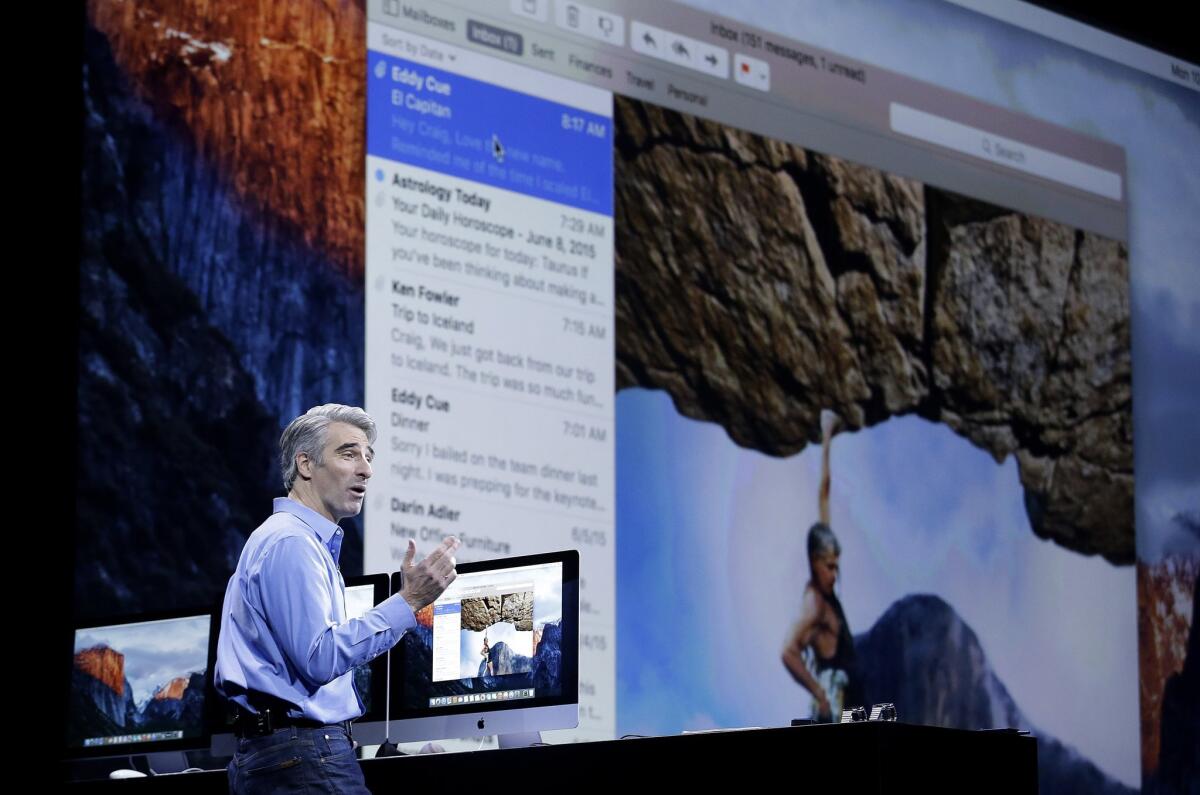Here are 3 key changes coming to Apple iPhones and iPads

Craig Federighi, Apple senior vice president of software engineering, discusses the El Capitan operating system at Apple’s Worldwide Developers Conference in San Francisco on Monday.
- Share via
Apple Inc. has had its share of buggy software updates. A new Maps app three years ago routed people into bodies of water. Last year’s Yosemite update led to dropped Wi-Fi connections. And new iPhone software packages have caused eager users to delete photos and apps to clear memory space for it.
When Apple’s latest batch of updates get released to the public in early fall, the company will have its hands full again. Here’s a look at three key changes Apple announced Monday at its developers’ conference in San Francisco and what glitches Apple undoubtedly will be trying to avoid when the public gets to use them. These are aside from Apple Music, a $9.99-a-month service for streaming songs and following musicians that launches June 30.
Multitask on the iPad (or at least the iPad Air 2): The ability to run apps side-by-side on an iPad is seen by analysts and Apple watchers as a precursor to the unveiling of a bigger iPad, which would be squarely aimed at converting more people from laptops to tablets. In the meantime, putting the feature exclusively on the latest iPad (the Air 2) could convince customers to upgrade their old tablets. Fewer-than-expected upgrades have contributed to declining iPad sales. If the feature isn’t as snappy as promised though, few may want to toss slower models they already have in hand.
Siri: Apple has improved the brains of both its digital assistant feature Siri and its search feature Spotlight. You’ll be able to type and ask things more the way you’d think about them in your head such as, “I want every email from my husband that has the word ‘real estate agent’ in it.” Most importantly, you can search for information stored on non-Apple apps. If Apple can get that right, you could pretty efficiently get fare quotes for Uber, Lyft and Flywheel in an instant. Apple says Siri has improved its accuracy and speed by about 40% over the last year, but better integrating apps from other companies could kick up that percentage dramatically.
Transit: Apple Maps is adding transit directions with the help of “precisely mapped” subway stations, among other things. Assuming Apple Maps doesn’t send people to Long Beach when they meant to get to Pasadena, the addition would be a critical step in getting more iPhone users to quit Google Maps or other transit apps from the App Store. Maps could eventually open new sources of revenue for Apple if it can show users that it has turned the corner after a poor start.
Notably, one area Apple didn’t discuss Monday was iMessage. Both Google and Facebook have competing products that are also rivaled by Snapchat and Kik in the U.S. and many others abroad. But neither Google at its developer conference last month nor Apple on Monday promised anything new for keeping users hooked on their chat services.
Apple did unveil a News app that delivers a personalized feed of stories from ESPN, CNN and other media outlets. But whether a News icon showing up on iPhone screens is enough to pull people away from reading and watching news on Snapchat or Facebook won’t be known for a few months.
Chat with me on Twitter @peard33




